- Joined
- Feb 14, 2005
- Messages
- 4,156
This is a family piece that I have recently fallen in love with and thought I''d share pics! It belonged to my great-grandmother (maybe even her mother, but we don''t really know). It isn''t in great condition (lots of chips on the girdle, etc), but it is lovely! It looks to me to be an OEC or European Cut, although I have found that not many jewelers know the difference and tend to call it a round Old Mine. It has quite a bit of body color to it (especially when compared to my D color stone), but it looks very appropriate - like aged lace.
I''m not sure what cut this stone is exactly - and I haven''t found a jeweler locally that I think knows either. I am guessing it may be a European Cut, based on this posting by Richard Sherwood from 2003:
* 1860-1900 Old Mine Cuts (cushion shaped outline)
* 1900-1915 Old European Cuts (round outlines)
* 1920-1935 European Cuts (more streamlined)
* 1940-1950 Transitional Cut (transitioning from European
* to Round Brilliant Cut)
* 1950-2003 Round Brilliant Cut
* These dates are not absolutes, but generalities.
*
* I have only heard the term transitional cut used referring to the transition from
* Euro to RBC. I don''t think it''s correctly used for the period of OEC transitioning
* to Euro Cut.
* Old European Cut characteristics- High crown, small table, short star facets, very
* large to extremely large culet, very large lower girdle facets, symmetry poor to
* good.
* European Cut characteristics- Lower crown, larger table, larger star facets, medium
* to large culet, smaller (but larger than modern RBC) lower girdle facets, symmetry
* usually better (fair to very good).
* If you can find out the proportions for your stone, we can tell you what era it
* falls in. A close up picture using a magnifier or loupe might do the trick as well.
* Rich, Independent GG Appraiser
* Sarasota Gemological Laboratory
* www.sarasotagemlab.com
If Rich or Old Miner or anyone else can offer their expertise regarding this stone, I''m anxious to learn anything I can about it!
Anyway - I used all of the toys Barry at Superbcert sent along with my upgrade stone to play with this ring, take pics, etc - then I took it in to a local jeweler to have the prongs repaired and an appraisal done. The light return doesn''t look too bad; the symmetry leaves something to be desired but the stone is beautiful in person. Gives off huge chunks of light, especially color, which I love!
The specs given on the appraisal are as follows:
(Diamond evaluated in mounting - weights and measures are approximate)
Platinum ring (stamped 10% Irid / Plat inside the band)
8 round Single-cut diamonds (2 chipped) - 0.09ctw, clarity VS2-SI1, Color G-I
Major: 1 round Old Mine Cut diamond - 1.17ct
6.7-6.9 x 4.08mm
D = 60%
S = Fair
Clarity: SI1
Color: K
Here''s some pics - there are a few in there taken along side my D color 0.74ct SuperIdeal H&A from Barry for comparison - I think it is so interesting to see two stones of the same round outline with such different personalities. As always, pictures don''t do it justice, but I hope you enjoy them none-the-less!
I''m not sure what cut this stone is exactly - and I haven''t found a jeweler locally that I think knows either. I am guessing it may be a European Cut, based on this posting by Richard Sherwood from 2003:
* 1860-1900 Old Mine Cuts (cushion shaped outline)
* 1900-1915 Old European Cuts (round outlines)
* 1920-1935 European Cuts (more streamlined)
* 1940-1950 Transitional Cut (transitioning from European
* to Round Brilliant Cut)
* 1950-2003 Round Brilliant Cut
* These dates are not absolutes, but generalities.
*
* I have only heard the term transitional cut used referring to the transition from
* Euro to RBC. I don''t think it''s correctly used for the period of OEC transitioning
* to Euro Cut.
* Old European Cut characteristics- High crown, small table, short star facets, very
* large to extremely large culet, very large lower girdle facets, symmetry poor to
* good.
* European Cut characteristics- Lower crown, larger table, larger star facets, medium
* to large culet, smaller (but larger than modern RBC) lower girdle facets, symmetry
* usually better (fair to very good).
* If you can find out the proportions for your stone, we can tell you what era it
* falls in. A close up picture using a magnifier or loupe might do the trick as well.
* Rich, Independent GG Appraiser
* Sarasota Gemological Laboratory
* www.sarasotagemlab.com
If Rich or Old Miner or anyone else can offer their expertise regarding this stone, I''m anxious to learn anything I can about it!
Anyway - I used all of the toys Barry at Superbcert sent along with my upgrade stone to play with this ring, take pics, etc - then I took it in to a local jeweler to have the prongs repaired and an appraisal done. The light return doesn''t look too bad; the symmetry leaves something to be desired but the stone is beautiful in person. Gives off huge chunks of light, especially color, which I love!
The specs given on the appraisal are as follows:
(Diamond evaluated in mounting - weights and measures are approximate)
Platinum ring (stamped 10% Irid / Plat inside the band)
8 round Single-cut diamonds (2 chipped) - 0.09ctw, clarity VS2-SI1, Color G-I
Major: 1 round Old Mine Cut diamond - 1.17ct
6.7-6.9 x 4.08mm
D = 60%
S = Fair
Clarity: SI1
Color: K
Here''s some pics - there are a few in there taken along side my D color 0.74ct SuperIdeal H&A from Barry for comparison - I think it is so interesting to see two stones of the same round outline with such different personalities. As always, pictures don''t do it justice, but I hope you enjoy them none-the-less!

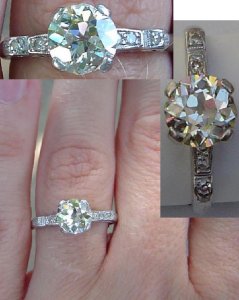
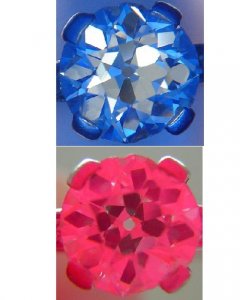
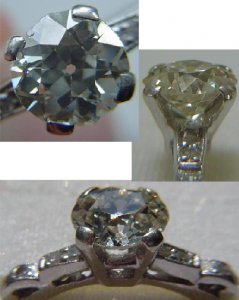
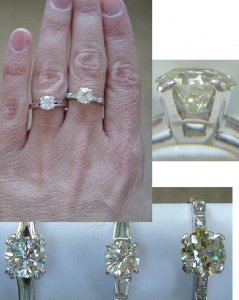
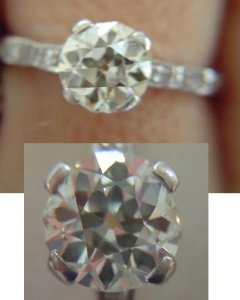
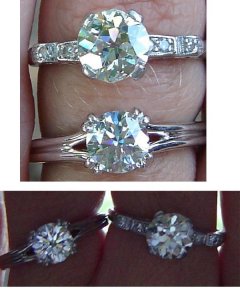








300x240.png)